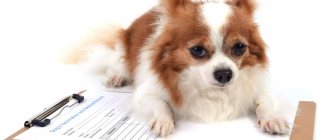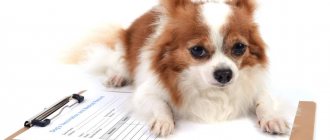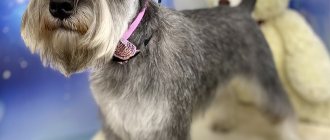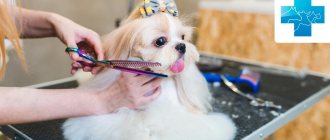Very often we hear about documents for our four-legged friends, which in their importance are not inferior to human ones. But not everyone knows why a dog needs a pedigree, and only experienced breeders and dog handlers have seen it, as well as owners of dogs who regularly participate in various exhibitions.
photo from website: petshealth.ru
For most owners of purebred puppies, the documents for them are only a veterinary passport issued at the clinic next door. Such dog breeders believe that they have truly international proof of the animal’s status. They are partly right: the certificate they received from the hands of doctors is indeed drawn up according to the international model. But such a certificate has nothing to do with pedigree.
Another document that the dog’s owner may have is a paper with information about microchipping the pet - installing a microchip under the dog’s skin. This device is necessary for searching for lost animals and identifying them anywhere in the world (for example, during exhibitions held abroad).
These documents are important, but they do not confirm that you are the owner of a purebred dog and not a mongrel. And you won’t find out about the origin of the pet in them. This requires special paper, which we will discuss in detail below.
Why do you need a dog's pedigree and what does it look like?
photo from website: decordog.ru
This is proof of your pet's relationship with other representatives of the purebred breed. It is necessary for those who want to engage in professional animal breeding, sell puppies with firm confidence in their “status,” and take part in various exhibitions without barriers.
More precisely, this is information about several generations of the family, a list of them, confirming the noble origin of the pet. Formally, such a document can be divided into three parts:
- The first is an indication of the number assigned upon issue, basic information about the pet (what breed it is, what its name is, when it was born, what color it is, whether there is a mark on the ear or a microchip installed under the skin). Also in this part are the details of the owner and the breeder who sold the dog (address and full name).
- The second is a kind of family tree of the puppy’s father.
- The third is a list of relatives on the mother’s side.
And if one of the parties does not provide information about the puppy’s ancestors, the document is considered incomplete. This paper also records the titles of the animal assigned to it at exhibitions.
RKF stamp database
To the disappointment of dog breeders, in Russia there is no single database of dog brands. Each significant canine organization maintains an individual file.
How dogs are branded by different cynological organizations:
- 3 Latin letters + 1-6 numbers – the mark of a member of the RKF.
- The RKF marks were not always the same as indicated in the previous list item. If the label includes 3 Cyrillic letters and any number of digital characters, then it was affixed before 2005. Such marks can be seen in older dogs.
- The first letter of the mark is E, then 1 or 2 numbers, followed by a Latin letter, and at the end 3-5 numbers. This is how dogs are branded by members of the SCOR (Union of Cynological Organizations of Russia). The numbers following E are the year the litter was born.
- KW + numeric and alphabetic characters in any order – the label of the International Canine Association “Kind World”.
What could be the pedigree?
There is a Russian version, which is valid only within the country, and an export version - it will be useful for those who regularly export their pets abroad.
A sample of an export pedigree for a dog looks like this (the form below is filled out in English):
photo from website: possessingdonjite.blogspot.nl
RKF documents for a dog: what is it and where are they made?
These include not only an issued certificate indicating that the dog belongs to a particular genus and breed, but also a birth certificate, which is issued to each dog during puppyhood. What is it for?
- This is the primary certificate that the four-legged fidget receives. It is issued to the owner by the association of cynologists, the owner of the kennel, and must be certified - not only by the signature of a responsible person with such authority, but also by the seal of the organization. If there are no such marks on the paper you receive, it may be legally considered unofficial.
- The metric contains basic information about the puppy: its breed, name, gender, features of the exterior and color, date of birth (in full), brand number (if any), details of the owner of the kennel engaged in breeding dogs (his full name and address ), as well as some information about the baby’s parents – certificate numbers, origin, etc.
photo from the site: gyabon.peugeot-incom.ru
- As soon as the animal turns 15 months old, the card must be exchanged for a certificate of origin issued by the Russian Canine Federation (RKF).
- How to get a pedigree for a dog? The first thing you need to do is provide the certificate issued to the puppy - without presenting the birth certificate, documentary evidence that the animal belongs to a certain genus will not be issued. The required paperwork is filled out based on the information received from the pet’s first document.
What is the difference between a chip and a stamp?
Instead of a brand, you can use a chip to identify your pet - a tiny circuit board implanted under the dog's skin using a special syringe. The identification code in the chip consists of 15 characters. The most common place of implantation is the withers. A special scanner is used to determine the code.
In addition to the identification code, the chip includes information about:
- gender of the animal;
- breed;
- nickname;
- color;
- vaccinations;
- date of birth of the litter;
- origin nursery;
- the current owner;
- veterinary organization that implanted the chip.
A chip has many advantages over a brand. Chipping is an almost painless procedure (pain is the same as from a regular injection). The implanted board does not need to be updated. But the main advantage is the unified Russian database of tagged animals - animal-id.ru.
The disadvantages of chipping are the high cost (about 6 times more than branding) and the availability of the procedure only in large populated areas of the country. In many regions, microchipping is not yet available, which means that hardly anyone will think of identifying a pet using a chip.
In Western countries, unlike Russia, labeling is no longer relevant. To cross the European border, your four-legged friend will have to be microchipped. Without a chip, as stated in the official requirement of the European Parliament, a pet will not be allowed into Western Europe. Many owners, if they have the finances, put both a stamp and a chip for reliability.
What is a zero or registered pedigree for a dog?
If we say the word zero, we mean the absence of something. So it is in the case of the concept being analyzed: we are talking about a certificate for a pet, information about whose ancestors has been lost. Or it never existed - in the event that the puppy’s parents are not included in various lists. However, the dog itself must be recognized as purebred - with official confirmation from experts.
photo from website: smartnews.ru
The preparation of such paper is associated with a number of limiting factors:
- The first is the absence in the certificate of information about the “relatives” of the animal. This is explained by the fact that they may be unknown or known - the latter option assumes that the ancestors have a pedigree that is not recognized by the RKF or FCI. These are documents issued by organizations “Good World”, UCI, etc.
- Dogs with a “null” may not be allowed for breeding (or are allowed, but with a reservation, which will be discussed below).
Thus, we are talking about a document issued to a purebred dog without a pedigree - and it is practically no different from a certificate of origin (with the exception of the obligatory letter “P” in the number). Why does its owner need such paper? There are several options: either for breeding without indicating the dog’s ancestors in the certificate, or for participation in various sporting events, exhibitions, etc.
In order to obtain a zero pedigree with the right to further breeding, you must provide the following documents:
- proof of the origin of the animal - papers from organizations recognized by the RKF;
- descriptions with high scores from 3 different exhibitions with confirmation of the dog being included in the catalogue.
How to make a pedigree for a dog without documents? This “zero” can be useful for those who plan to regularly take their pet to exhibitions - however, without the possibility of receiving a championship title. To complete it, it is necessary to provide RKF with descriptions from exhibitions (3) with satisfactory ratings from experts and an obligatory mention of the dog in the catalogue.
The submitted forms, the forms of which can be found on the official website of the Russian Canine Federation, should be accompanied by two photographs of the pet (in profile and frontal view).
Types of markers and application techniques
Alabai with ears (undocked): when the ears and tail of puppies are docked
Before branding puppies, you should decide on the device for applying it. There are two ways - using a tattoo machine and branding tongs. Both options have positive and negative properties.
Popular articles What breed of dog is in the film “The Hound of the Baskervilles”
Mechanical forceps resemble scissors in appearance. A set of letters and numbers, which are equipped with needles, is purchased separately. They are used to apply a tattoo. The advantage of this method is that branding occurs with one press of the tongs. It's quite quick and painless. Next, paint penetrates into the punctures.
The tattoo machine comes in three varieties:
- rotary kleimator;
- induction machine;
- pen.
The most popular option is the rotary claymator. It is a small machine that fits in the palm of your hand and makes virtually no sounds. This minimizes the risk of scaring your pet. Suitable for both large breeds of dogs (German Shepherd, Labrador) and small ones (Yorkie, Chihuahua, Spitz).
The induction machine is less popular, but it also has an undeniable advantage - the code is clearly visible for a long period, which avoids repeated branding.
The branding pen looks like a writing pen, it is easy to use, silent, lightweight, and suitable for applying a code to small dogs.
Everyone chooses for themselves how to brand a puppy and the most convenient tool for this.
Types of claymators
How to make a pedigree for a dog: preparing documents for your pet
photo from website: elitkovka.ru
The document issued by the RKF can be obtained by Moscow residents at the organization’s office, which is open on weekdays from 10 am to 6 pm. For those who live in other cities of Russia, all that remains is to negotiate with the owners of the nursery or club. They send the necessary information by courier for a fee.
For Muscovites, the entire process will take 4 weeks, for nonresidents – up to 3 months. Here's how to register and receive a dog's pedigree in the RKF. The owners are only required to provide the necessary document - a card, which is given to the owner of the animal when purchasing it from a nursery or private club.
What to do if there is no metric for a puppy?
photo from the site: newstes.ru
In this case, there is no need to panic: you can still get a pedigree. True, only register. In this case, confirmation of belonging to a particular breed will be a mark on the pet’s ear or an expert assessment.
It’s worth waiting until the dog is six months old - then the documents about the litter to which he belongs will be in the RKF and you won’t have to wait. There is also no point in delaying obtaining a certificate, because the Federation of Cynologists has also set a deadline for applying for a pedigree - 1 year and 3 months. Of course, the owners of a five-year-old dog can try their luck, but they will not have a metric on their hands, the validity of which ends as soon as the puppy turns 15 months old. Think for yourself whether it is worth sending documents to Moscow in advance - in the end, the decision to participate in exhibitions without restrictions and receive paper with information about the dog’s ancestors is made only by you.
Procedure
After receiving the number from the RCH, the puppy needs to be prepared for tattooing. You can apply the ID at home if you have sufficient skills, or you can contact a specialist.
First of all, the area around the future tattoo is cleaned, excess hair is shaved off, and the area is disinfected. The procedure itself takes no more than fifteen minutes. Some methods can reduce branding time to four to five minutes.
For puppies, such a procedure is almost painless, but this does not mean that they will not try to dodge and escape. The pet's paws and body should be firmly fixed to provide the specialist with free access to the working area.
At what age is it best to carry out branding?
You can get a tattoo on an animal at any age. And yet puppies are branded at the age of a month and a half. The most common age is forty-fifth day after birth. It is worth noting that a puppy is much more tolerant of branding than an adult dog.
Read What is puppy activation and why is it needed?
Where is the mark placed?
Dogs are most often branded on the ear. They are also placed either in the groin area, on the inner thigh or on the stomach.
Popular articles How to choose and use cat diapers correctly
How to check a dog's pedigree: what to do if someone slips you a fake
This option is completely excluded if you receive a certificate of origin of the pet directly from representatives of the RKF. A fake can fall into the hands of a future owner only if he buys an already grown dog or puppy at a poultry market or from unverified sellers who can issue a regular “fake” printout instead of the original certificate. The original paper must have the necessary signatures and watermarks, as well as a hologram and emblems of the Russian Canine Federation and FCI.
You also need to check the puppy's first document - the metrics. According to the rules, it must bear the seal of the club/kennel and the signature of the owner of the organization.
How to read a dog's pedigree
photo from website: rossiyacredit.ru
Do not forget that we are dealing with a family tree of animals - it has its own fathers and mothers, grandmothers and grandfathers. The FCI document includes 3 generations of your pet's ancestors, so getting to know each other will take a long time.
The names of the dogs are arranged in a simple sequence - the fathers are always located above the mothers (at the top). You should also remember the following rules for drawing up a pedigree:
- The dog to which the certificate belongs is highlighted from the left edge of the sheet and is considered the main one.
- The information about the pet indicated in the paper about the origin includes information about the color and name of the breed, as well as the nickname, assigned number, information about the owner and the person who was breeding.
- An ancestor whose registration number was not included in the stud book casts a shadow on the entire family. And this is not a joke - this is enough to recognize the dog as not purebred.
Common Mistakes
Some owners believe that the brand is not necessary and can be added later if necessary. This is an erroneous judgment. The mark is given to puppies up to 45 days of life. The tools used for branding are not capable of penetrating the thickened skin of an adult animal. If attempts are made to put a mark, the information very quickly becomes unreadable.
An adult animal is only allowed to renew the mark, which fades over time. It is a mistake to believe that the stigma is present in non-pedigreed dogs. A tattoo with the owner's contact information (for example, phone number) is not accurate. If the animal was not branded on time, the owner of such a dog should think about an alternative in the form of a microchip.
The process of branding is a safe method. The danger when marking an animal is exactly the same as when tattooing a person. Specialists use disposable needles and disinfect surfaces, observing the rules of asepsis and antiseptics.
If a specialist does not have experience, carries out the procedure with low-quality ink, or does not follow safety precautions, the risks of inflammatory processes and suppuration at the site where the pigment is introduced under the skin increase. A mistake that can be made when stamping is incorrectly entered data in the metric or the mark itself
Thus, the information varies and the animal cannot be identified in a common database. In such cases, owners are recommended to seek help from the club to change the information in the metric or carry out the procedure for editing the brand.
A mistake that can be made when stamping is incorrectly entered data in the metric or the mark itself. Thus, the information varies and the animal cannot be identified in a common database. In such cases, owners are recommended to seek help from the club to change the information in the metric or carry out the procedure for editing the brand.
Modern technologies make it possible to abandon the branding procedure in favor of chipping. A microchip can be placed on puppies that already have a brand and, on the contrary, microchipping does not require a branding procedure.
Moreover, in developed countries, microchips have gained popularity and now owners planning to travel abroad with an animal must ensure that the pet has a microchip under its skin.
The advantages of branding and microchipping are the ability to quickly locate the animal. Unified databases created for animals allow you to quickly identify a dog using a scanner that reads information on a microchip. The unified database also contains information about branded dogs.
Microchipping can be carried out on outbred puppies and stray dogs. Having a chip does not oblige you to have a purebred dog. The information on the microchip allows you to quickly find a lost dog that does not have a pedigree. This is convenient, because not all dogs that have become true friends and companions for their owners are of purebred origin.
Author and presenter of the column: Veterinarian Nikolay Evgenievich Smirnov
Due to the large flow of incoming questions, free veterinary consultations are temporarily suspended.
The main question: why do ordinary dog breeders need a pedigree?
photo from website: wclub.ru
Some owners get an animal for the hobby, some - for constant trips to exhibitions, raising a thoroughbred winner and a real champion. This often happens: at first they take a puppy, without being interested in the documents accompanying it, and only after that they begin to wonder about the origin of the baby, who his mother, father are - close and distant canine relatives.
I would like to give the following advice to those who are just planning to get a pet: if you do not plan to devote your life to breeding toy terriers, beagles, spitz dogs or Dobermans, collect all the titles and excellent marks in competitions for our smaller brothers, you don’t need to register a pedigree in order to it didn’t gather dust behind glass like a useless piece of paper that was only taken out to show off to guests. But for those who want their dog to become a star at Russian and international exhibitions or to continue a glorious family line, they will need important paper.
And don't forget: the animals you tamed will always be your true friends. Appreciate them regardless of whether they have a certificate of noble birth or not.











